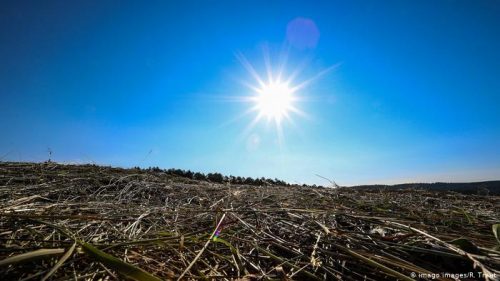
How does weather affect COVID-19?
All data and statistics are based on publicly available data at the time of publication. Some information may be out of date.
Why are these findings so controversial, and why has the United States seen most cases during its hot and humid summer? In this special feature, we investigate which weather conditions are most associated with COVID-19 cases.
We look at what factors might confound these studies and make them hard to interpret. And we describe how one international study tries to get around these problems.
There are good reasons to expect a respiratory virus to show seasonal variation. Infections from influenza and respiratory syncytial virus are more common during winter in temperate areas of the world.
Studies of the first SARS-CoV in 2003 suggest weather might be important for coronavirus spread. While this virus did not circulate long enough to establish any potential seasonal pattern, daily weather was associated with the number of cases. In Hong Kong, new cases were 18 times higher in lower temperatures — under 24.6°C, 76°F — than more elevated temperatures.
The epidemic died out during a warm, dry July in 2003, but tight public health control measures were also in place. A recent review of the seasonality of respiratory infections describes how cold, dry winter weather makes us more susceptible to viruses in general.
In these conditions, the mucous lining in our noses dries up, which in turn impairs the function of cilia, the tiny hairs that line the nasal passage. These beat less often, meaning they may fail to clear viruses from the nose. The review concludes that a relative humidity of 40–60% might be ideal for respiratory health.
Americans spend 87% of their time indoors, so how does the outside weather affect them so much? When cold, dry air meets warm air from indoors, it reduces the air’s humidity inside by up to 20%. During winter, indoor humidity levels are 10–40%, compared to 40–60% in fall and spring. The lower humidity aids the spread of virus aerosols and could make the virus more stable.
Laboratory and observational studies of cases of COVID-19 patients show an impact of humidity on the SARS-CoV-2 virus.
A laboratory-generated aerosol of SARS-CoV-2 was stable at a relative humidity of 53% at room temperature, 23°C, 73°F. The virus had not degenerated much even after 16 hours and was more robust than MERS and SARS-CoV. This helps explain its higher levels of airborne infectivity.
Laboratory studies do not necessarily predict how a virus will behave in the real world. However, a study of 17 cities in China with more than 50 cases of COVID-19 found a link between rises in humidity and reductions in COVID-19 cases.
The team measured humidity as absolute humidity, or the total amount of water in the air. For every gram per cubic meter (1 g/m3) increase in absolute humidity, there was a 67% reduction in COVID-19 cases after a lag of 14 days between the humidity increase and the number of cases.
Experts report similar associations between the number of cases and humidity in Australia, Spain, and for both cases and deaths in the Middle East.
The way temperature and humidity interact provides different weather patterns, which are determined by latitude.
Links between COVID-19 cases and temperature are less certain. Studies from China have both found and not found an association with environmental temperature.
Similarly, researchers report no effect of temperature and COVID-19 transmission or deaths in Australia, Spain, and Iran.
However, higher temperatures are associated with a lower number of cases in Turkey, Mexico, Brazil, and the U.S., but it appears there is a threshold. Higher temperatures do not cause a further decline in COVID-19 transmission, which could account for some of the disparities.
This is consistent with laboratory studies that show the SARS-CoV-2 virus is highly stable outside the body at 39.2°F (4°C) but increasingly unstable at temperatures above 98.6°F (37°C).
A study in Spain found after 5 days of lockdown, the longer the hours of sunshine, the more cases there were of COVID-19. This positive association held true with a lag — between sunshine hours and cases — of 8 and 11 days. There was no link between the hours of sunshine before lockdown and during the first 5 days.
This contradicts findings from influenza research, which suggests lower transmission with longer hours of sunshine. The authors say:
In contrast, there appears to be no effect of solar UV light, as the wavelength required to kill viruses and bacteria is under 280 nanometers (nm).
This type of UV light (UVC) does not reach Earth as it is absorbed in the ozone layer. If it did reach Earth, humans would suffer severe burns to their skins and eyes within minutes.
Some minor effects of UVB light, defined as 280–320 nm, have been proposed to explain the contradictory findings of lower transmission of COVID-19 in cold and dry conditions at a higher altitude. However, other factors, such as higher vitamin D levels within people in these regions, might be more important.
To overcome the problem of non-weather factors that confuse the picture of seasonality and COVID-19, an international group of researchers has analyzed the severity of COVID-19 instead of the number of cases.
Using data from admissions to six European hospitals and 13 hospitals in the Zhejiang province in China, they found decreases in deaths, the average length of stay, and admission to intensive care units for COVID-19 with each additional day of the pandemic.
This was found in most of the European hospitals, but not the Chinese hospitals. China’s pandemic rise took place entirely during winter, while in Europe, COVID-19 spread throughout the winter and spring months.
Deaths decreased in the European hospitals with each unit of temperature increase but not in the Chinese hospitals. The authors disregarded improvements in treatment during February and July, citing only a small impact from the use of dexamethasone.
They hypothesize the decrease in severity is related to humidity-driven changes in nasal mucous and viral clearance by nasal cilia.
What this study means
This research is a preprint and observational study. Therefore, it cannot establish causal links, but it does go some way to overcome the potential confounding factors in earlier weather and COVID-19 case studies.
If COVID-19 is seasonal, experts will likely establish this in 2021 or 2022 after the main pandemic waves.
In the meantime, the authors suggest the importance of considering hydration for patients and the public, including the ancient practice of nasal irrigation.
